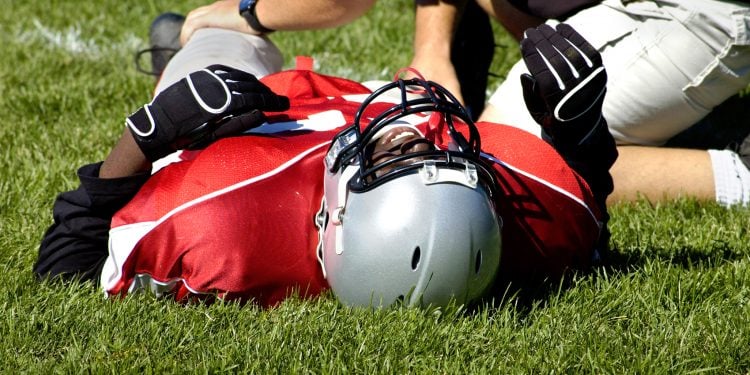As fitness professionals and sports enthusiasts, we know how devastating an ACL injury can be for an athlete, both professional and recreational. Discover how the NASM Corrective Exercise Continuum can be used to help prevent this potentially career ending injury.
The National Football League (NFL) represents the height of organized football, employing the best players from around the world. Most of these players have dedicated their entire lives to the sport, demonstrating the many qualities required to stand out above their peers in hopes of being one of the greats. Unfortunately, many of these dedicated athletes see an early end to their career due to injury. The most common and likely injury to end a career is an anterior cruciate ligament (ACL) tear (4). Each year, anywhere from 100,000 to 250,000 ACL injuries occur, many in young athletes (3, 5).
ACL reconstruction ranked sixth among the most common sports related surgical procedures performed in 2004 (5). The top players in the NFL are no less susceptible to ACL tears. In fact, 219 NFL players suffered ACL tears between 2010 and 2013 (4). Of the 219 ACL tears, 27 of them were re-tears. Although all positions in the NFL are susceptible to ACL tears, interior offensive and defensive lineman have higher risks of ACL injury than perimeter lineman (4). There are many factors, both internal and external, that play a role in ACL injuries (4, 5). An overwhelming number of ACL injuries (70-75%) are considered non-contact and mostly occur during deceleration of the body, which is an internal mechanism (2).
Specific training programs designed to restore proper muscle balance and improve neuromuscular control through stabilization exercise decreases ACL injury rates and boosts athletic performance (1-5). Through proper assessment and application of the NASM Optimum Performance Training ™ (OPT™) model and the NASM Corrective Exercise Continuum, training professionals can play a role in preventing injury or improving recovery from injuries like ACL tears (1-3). Although, most fitness professionals will not work directly with NFL players, many of us will work with the general population and young aspiring athletes that are just as susceptible to non-contact injuries like ACL tears, which can have drastic consequences such as temporary and permanent disability, missed work, school, or participation in sports (5).
ACL and other lower-extremity injuries occur most commonly during planting and cutting maneuvers. This is due to insufficient neuromuscular control of lower limb mechanics, particularly in the frontal plane (3). The most common movement pattern occurring at the time of non-contact ACL and other lower-extremity injury is an internally rotated femur moving the knee position inward (known as a valgus position) and externally rotated lower leg (2-3, 5). This unstable position places great strain on the ACL, which may be sufficient enough to cause spontaneous rupture of the ligament (2). Through proper movement assessments, like NASM’s Overhead Squat Assessment and the Single Leg Squat Assessment, we can identify these same compensation patterns in a controlled environment and begin to correct them (1-3).
Every good corrective program begins with assessment. When assessing the movement of your clients, look for compensations within the kinetic chain, such as the knees moving inward and the feet flattening and/or turning out (1-3, 5). These compensations are clear signs that your client may be at higher risk for injury (1-5). These compensations exist because of poor muscle balance (improper length-tension relationships) and/or improper recruitment patterns (force-coupling) around a joint (1-3).
Once you identify the movement compensation, you will have a better idea which muscles are overactive and which muscles are underactive. In most cases the overactive muscle will be the synergists of what is supposed to be the prime mover for a specific motion, and the underactive muscle will be what should be the prime mover. We call this synergistic dominance (1-3). Although there are many reasons that would cause a prime mover to take a back seat to a synergist muscle, the most common cause is general overuse and fatigue due to poor recovery (1-3). By applying the Corrective Exercise Continuum, we can begin to reduce these compensations and improve muscle recruitment patterns (1-3).
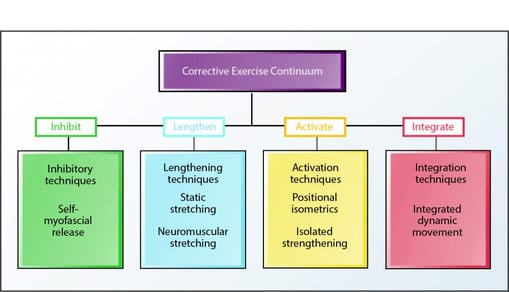 NASM's Corrective Exercise Continuum
NASM's Corrective Exercise Continuum
The Corrective Exercise Continuum follows a four step process; inhibit, lengthen, activate, and integrate (3). It is important to start with inhibiting the overactive muscles with self-myofascial release (SMR) techniques, such as foam rolling, followed by static or neuromuscular stretching to lengthen them. In the case of ACL tear prevention or recovery, the most common overactive muscles that lead to the compensation of knees moving inward and/or feet turning out are the calves, lateral hamstring, TFL/IT-band, and adductor complex (1-3). Next, you need to activate the underactive muscles (gluteus medius, VMO, medial hamstring, etc.) with isolated strengthening exercises (1-3). Resisted hip abduction would be an example of an isolated strengthening exercise focused on activating gluteus medias (1-3). Exercises focused on movement around a single joint work best. Finally, both sets of muscles will need to be integrated and cued to work together to create proper movement across multiple joints. Step-up to balance, single-leg balance reach, and hop to stabilization are all examples of integration exercises that provide opportunity to improve your client’s neuromuscular coordination, proprioception, balance, agility, dynamic stability, and technique, all critical components to a solid ACL injury prevention exercise program (2).
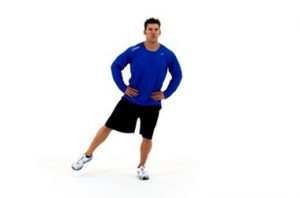 Single-Leg Balance and Reach
Single-Leg Balance and Reach
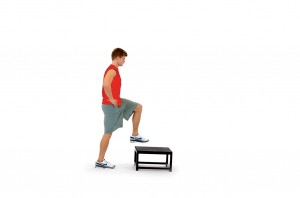 Step-Up to Balance
Step-Up to Balance
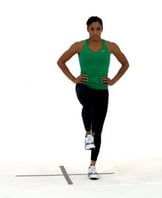 Hop to Stabilization
Hop to Stabilization
Once assessed, the implementation of the four step corrective exercise process can be accomplished by a practiced fitness professional in as little as 7-12 minutes, depending on the number of compensations present and the goals of that particular training session. This process can be done as part of a warm-up before a workout or as the focus of a training session on its own. By taking a few minutes to screen for movement compensations and other injury risk factors, we can play an active role in reducing these types of career-ending and life-changing injuries.
Reference:
- McGill, E., Montel, I. (2017). NASM Essentials of Personal Fitness Training, 5th ed. Burlington, MA: Jones & Bartlett Learning
- Clark, M., Lucett, S., & Kirkendall, D. T. (2010). NASM Essentials of Sports Performance Training. Philadelphia: Wolters Kluwer/Lippincott Williams & Wilkins.
- Clark, M., Lucett, S., & Sutton, B. G. (2014). NASM Essentials of Corrective Exercise Training. Burlington, MA: Jones & Bartlett Learning.
- Dodson CC, Secrist ES, Bhat SB, Woods DP, Deluca PF. Anterior Cruciate Ligament Injuries in National Football League Athletes From 2010 to 2013: A Descriptive Epidemiology Study. Orthop J Sports Med. 2016 Mar 3;4(3):2325967116631949.
- Hewett, T. E., Shultz, S. J., & Griffin, L. Y. (2007). Understanding and Preventing Noncontact ACL Injuries (9th ed., Vol. 34, Ser. 2006). Champaign, IL: Human Kinetics.

